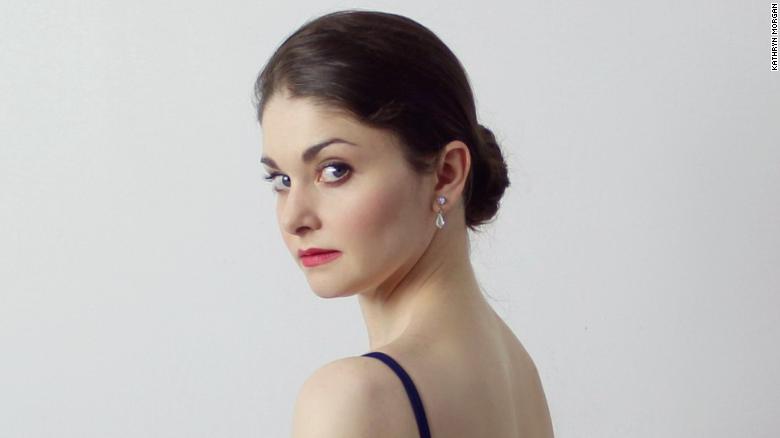‘I have nothing to braid’
Morgan was 21 and rehearsing Aurora again when her once straight road began to fork. “I remember being extra tired and not fully myself, but I thought it was just because I was doing ‘Sleeping Beauty’,” she said. “And then spring season started, and I could barely get through a day of rehearsal, let alone performances, I was so exhausted.”
Cast once more as Juliet, Morgan was having her hair braided for a performance when the stylist expressed alarm. “Three months ago you had twice as much hair,” he told her. “Your hair is gone. I have nothing to braid.” Rapid weight gain followed, despite a grueling 60-hour week schedule.
“My joints started to hurt, my ankles started to hurt, I couldn’t get my leg up as high,” Morgan said. “My muscles started disintegrating as well. I would go up to pointe and suddenly I couldn’t balance any more. It was terrifying.”
With suspicions of mono, she went to the doctor, who diagnosed her with an underactive thyroid and prescribed medication. “I thought, ‘Great, wonderful, we’re good to go,’ ” she said.
Over the next two years, she continued to deteriorate, repeating an agonizing cycle of accepting prized roles and being forced to pull out soon after. “I couldn’t get through the day without a nap,” she said. “I couldn’t get through a ballet.”
Eventually, the ballet master asked to speak to her in his office. “He asked me how I was feeling, and I just burst into tears and lost it,” Morgan said. “I said, ‘I cannot do this any more. I am so miserable.” She anticipated three months away from the stage at most; three years later, nothing had improved. “I was on such a high dose of medication — it was the dose people who have their thyroids taken out completely would be on,” she said. “I felt like I was in somebody else’s body. I had balance problems. I couldn’t control my limbs.”
การยอมรับจากแพทย์
Despite her initial hypothyroidism diagnosis, doctor after doctor dismissed her concerns, deeming her a healthy young woman with probable hypochondria.
“The problem was that because of how small I was to begin with, even after I gained weight, all these doctors were looking at me going, ‘You look fine. Are you making this up?’ ” she said.

It was her eighth doctor who eventually diagnosed Morgan with an autoimmune condition: Hashimoto’s disease, also known as Hashimoto’s thyroiditis.
The illness sees antibodies attack the thyroid gland, ultimately resulting in a decrease in thyroid hormone production; according to the American Thyroid Association, thyroid hormones enable the body to “use energy, stay warm and keep the brain, heart, muscles, and other organs working as they should.”
การวินิจฉัยโรคที่พบบ่อย
โมโตะ
Afflicts about 5 out of every 100 people in the United States, the National Institute of Diabetes and Digestive and Kidney Diseases says.Dr. Mary Vouyiouklis Kellis, an endocrinologist at Cleveland Clinic, told CNN that the disease is “about five to eight times” more common in women, and typically diagnosed in patients aged 40 to 60, though Morgan’s earlier diagnosis isn’t abnormal.
Alongside Morgan’s symptoms, people with Hashimoto’s might experience dry skin, cold intolerance, weak shoulders and hips or mood fluctuations.
“Having irregular periods can be a first sign, or even bowel movement changes or constipation. Issues with performance and muscle recovery could become problematic,” Vouyiouklis Kellis said.
“Untreated, if it gets severe and the body’s unable to produce any thyroid hormone, everything starts to slow down. You can have memory issues, slow speech, slow movement — you can even develop fluid around the heart and fluid in the lungs. The heart rate can also slow down.”
When Morgan first left NYCB, she was thankful for the break. “I didn’t want to be in class, I didn’t want to have anything to do with ballet. Going in every day, looking at yourself in the mirror in a leotard and not recognizing yourself, having other people do the full body scan — it was humiliating.”
Ballet’s notoriously narrow beauty standards compounded her misery. “You have to look beautiful and make it look effortless and yet you’re doing these extremely difficult physical things,” she said. “You have to be the model and the athlete at the same time.”
Soon, however, she returned to the “do or die” mindset that had fueled her entire career. “As dancers, we have this mindset of having to be perfect all the time,” she said. “I had to get back on stage because I felt like a failure if I didn’t.” By 2014, when she was interviewed by the New York Times, she thought her comeback was imminent. Instead, she relapsed.
“My body freaked out a second time,” she said. “I still wanted it so badly, but my body just wasn’t ready. My hair started falling out a second time. Everything just happened again.” With a dancer’s characteristically unforgiving self perception, she began to consider herself a “has been.”

‘Plan B career’
Around the same time, Morgan launched a YouTube channel, initially created to combat rumors that she had been fired from New York City Ballet. Soon, she began to dispense her wisdom to younger dancers. “It occurred to me that there were no professional ballet dancers on YouTube — just the occasional 12-year-old giving rather questionable advice,” she said. On her channel, which now has over 150,000 subscribers, she offered advice on topics from nutrition to technique to stage make-up, often posting full-length, follow-along ballet classes. “One of the key things I like to talk about is the mental side of ballet,” she said. “That’s not talked about. Dancing is such a mental thing, and if you’re not in a good mindset, no matter how talented you are, it’s never going to work.” Above all, she hoped to empower her young followers — and not only to pursue a career in ballet. “If you’re dancing and you’re unhappy, and you want to do something else, you are not a failure,” she said.
As returning to the stage began to seem an ever more distant fantasy, Morgan focused on YouTube, taking teaching jobs and writing an advice column on the side. “I became known as this ballet advice guru,” she said. “It kind of became this Plan B career.”
In 2017, she got married, and saw in her relationship a natural ending to her performing life. But 10 months after the wedding, the marriage broke down. To deal with her pain, she returned to the ballet studio; she hadn’t worn pointe shoes in three years. “I didn’t go back thinking, ‘I’m going to be a professional dancer.’ It was just something for me to do that fed my soul,” she said.
Without the pressure to return to her career that she once felt, Morgan saw surprising results. “Because I was not putting such a mental strain on myself to get back in shape, I did,” she said. Her doctor was stunned.”What happened?” she recalled him saying. “In eight years I haven’t seen you look this good.”
The long-suppressed hope of dancing professionally again began, incredibly, to seem possible. Morgan is now 30 — young in any career but ballet, which often forces retirement before 40 thanks to years of relentless physical strain.
“But I’m not a beat up 30-year-old,” she said. “Most ballerinas, by the time they get to 30, they’ve been doing this for several decades, but I had this big, long break where all my injuries healed. I wasn’t pounding myself into the ground for the last decade.”
Comeback 2.0
In February this year, Morgan contacted Lourdes Lopez, artistic director of Miami City Ballet. Lopez couldn’t guarantee her a position in the company, but invited her to visit and take class.
“I think we spoke for about an hour, and she told me about her life. She was so honest and so open and so humble,” Lopez said. “She was so grounded and mature. I loved that.”
Morgan had a “God-given presence” when she danced, Lopez said. “She’s highly, highly talented, highly musical, with a very dramatic quality about her,” she told CNN. “You could tell she was getting her health back, but she said, ‘I know. I can’t wait to get back to the studio and start to work.’ “
“I don’t want to say she got her talent back, because I don’t think she ever lost it,” Lopez said.
On April 1, she called Morgan with an offer: a soloist contract at MCB, the same rank she’d once held at NYCB. “In my head I’m going, ‘It’s April Fool’s Day — is this a joke?’ ” Morgan said. She accepted the offer, and a few weeks later, told her YouTube followers. In the วีดีโอ, which has more than 67,000 views, over 7,000 likes, and almost 2,000 comments, she swallows tears as she shares the news she once expected would never come; in the comment section, viewers say they cried with her. In June, she moved to Miami; in October, she’ll make her official return to the stage.
In the second half of her performing career, life will be different, Morgan has resolved. “When I was younger, I had no social life. I had nothing outside of ballet,” she said. “When I got sick, I didn’t know how to function.” At MCB, she’ll make time to see friends, to date. She’ll continue making videos, and maybe write a book about her experiences.
Her perspective, too, has changed. “Each day now dancing is a gift because I truly thought I was done. This has given me a whole new appreciation for what I do,” she said.
“I know my strengths and weaknesses now,” she added. “I am a lyrical, adagio, dramatic dancer — I’m never going to be able to do all the tricks and I’m fine with that. I used to beat myself up for not being able to do five pirouettes; now I’m like, ‘Nope, I’m good with that.’ “
The risk of relapse can never fully be banished, Morgan knows — but experience has taught her the futility of planning too far into the future. “At New York City Ballet, everything was wonderful and then it totally changed overnight,” she said. “So in Miami, I’m going to take it one day at a time and go from there.”
Vouyiouklis Kellis said that anyone who suspects they might have a thyroid condition should first see their primary care provider for an initial diagnosis. “Because the thyroid affects so many organ systems, it’s hard to know whether something is truly thyroid related, and that’s why it’s important to have the blood tests,” she said.
Morgan credits a tailored diet — she is gluten intolerant, she discovered — and carefully managing stress with her recovery. But the advice she dispenses the most is different and more urgent, shaped by years of unexplainable sickness and a string of doctors who didn’t believe her. “You know your own body. You’ve got to stand up for yourself. If someone won’t take you seriously, keep trying until someone will, because it took me eight doctors but I found someone,” she said.
“When you know in your brain something is wrong, keep trying.”



